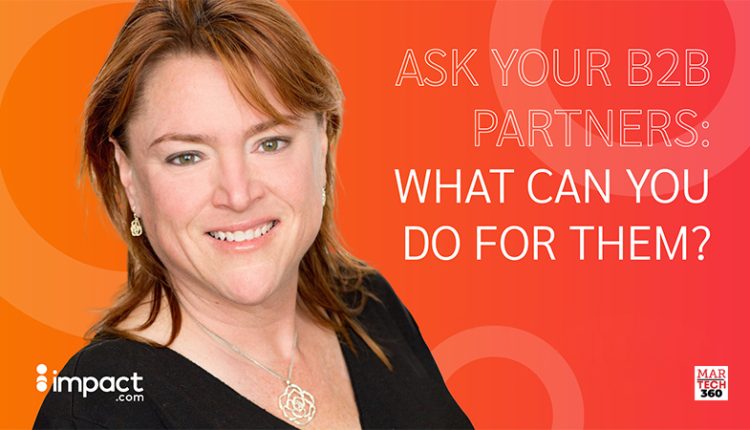“Ask your B2B partners: What can you do for them?”
Natalie Elliott, Events Marketing Manager at impact.com, reports from the audience as company co-founder Lisa Riolo takes the (digital) stage at this year’s AMPLIFY Summit to discuss B2B partnerships
Each year, the AMPLIFY Summit from Affiliate Insider brings a little sunshine to the month of January and, with the industry returning from holiday season, helps to set the tone for the year to come. With impact.com’s co-founder Lisa Riolo featuring in the B2B session, this year’s event was highly anticipated.
Affiliate Insider’s founder Lee-Ann Johnstone chaired the session, and virtual delegates were treated to insights from some of the industry’s brightest sparks, covering everything from big trends for 2023 to the secrets of running a successful B2B partnership programme. So, what did we learn?
What is a B2B partnership?
There are a couple of different definitions of what exactly constitutes a B2B partnership, which can be confusing. The main types are partnerships that either conform to the B2B business model – whereby businesses are looking to influence other businesses – or those in which companies partner with other brands to promote their products or services to each others’ audience.
Also Read: Image Streaming: Bringing transparency and fairness to the media supply chain
During the panel Lisa was also keen to highlight that a B2B partnership is only successful if both factions are committed to a deep and extended relationship that engages consumers through the full length of the purchase cycle – and that such relationships are increasingly common.
“We’d expect the explosion in the number of B2B partners arriving on the scene to hugely benefit marketing activities this year,” said Lisa, who noted that partnerships should never be regarded as one-stop-shops designed to make a quick buck, but models of deep integration between businesses and brands.
A new frontier for affiliates
A common theme throughout the panel was the way in which affiliate partners are evolving towards the B2B space. Tyler Calder, CMO of PartnerStacker, was keen to demonstrate the significant opportunities that the traditional B2B business model offers affiliates: the economics of the model mean that most B2B organisations will pay out over the lifetime of a customer conversion. “Affiliates are now building generational wealth in a way B2C simply can’t offer,” said Tyler.
B2B Trends for 2023
The panel agreed that 2023 is going to be huge for the partnership economy, especially in the B2B sector. Last year the partnership penny dropped for the wider marketing world, and 2023 is about building on last year’s progress – especially given the global economic downturn and the attractive efficiencies partnerships offer marketers, especially in the burgeoning B2B affiliate space. “We have seen plenty of recognition that influencers can successfully speak to businesses using a SaaS model, and we expect this model to become more prevalent,” said Lisa. She also believes that tech integration partnerships – in which two businesses connect their tech to benefit both sets of customers – will become increasingly common. “Brands should especially look at service providers as potential integration partners,” she added.
How to get started?
There are hard and fast rules for getting started in the B2B partnership economy. First of all, know who you want to reach, and which partner will help you speak to this audience. Then, have an open and honest discussion around KPIs and expectations with any potential partner. If these intersect to an acceptable degree for both parties, you’re onto a winner.
Of critical importance is understanding the economics of any potential deal, so all those involved should discuss their KPIs issues early in the relationship, because the partnership must be of value to all stakeholders. Avoiding ambiguity in every area of the partnership is important, the panel agreed. For example, avoid setting vague programme goals and don’t over-complicate your reward model.
Finally, think about which stakeholders within your respective organisations might contribute to a partnership’s success. “If the partnership might involve product or marketing integrations, it’s great to ensure appropriate team members are involved in the conversation as early as possible to ensure a holistic approach,” suggested Daniel Lancioni, Senior Director of Partnerships at Reveal.
Go Deep
Lisa made the point that knowing your partnership cost of acquisition numbers is important, as it proves the value of this activity to any leadership who may be concerned that it could clash with more traditional sales operations. Lee-Ann wrapped up the event with an appeal to all partners to commit to partnerships fully – to “go deep, immerse yourself and build long-term, transparent relationships” to reap the full rewards.
Lisa closed with a simple formula for success: “Rather than asking what any affiliate or partner can do for you, consider what you can do for them – because this is the cornerstone of every successful relationship, and this is what builds long-term partnership success.”


Comments are closed.